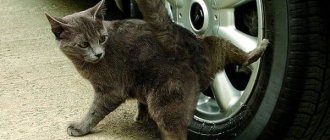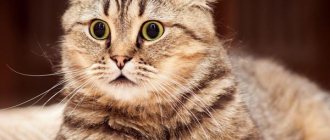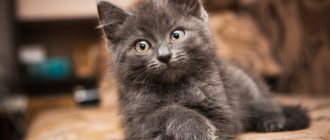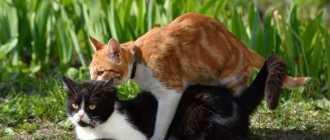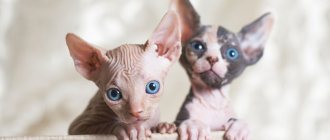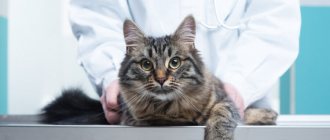Looking at a small pet, many owners wonder: to what age do cats grow when their tiny lump turns into a big handsome one. The growth of a cat directly depends on many factors:
- from the breed of the animal;
- on the size of the pet’s parents (heredity);
- from feeding;
- from past diseases.
Important! On average, cats grow up to 14-15 months, but in some animals growth ends a little earlier.
Growth and development of kittens
Kittens of different breeds are born with different weights - from 60 g to 200. This also depends on how many kittens were in the litter: the fewer, the larger the babies will be.
Felinologists distinguish several stages of development and growth of kittens:
- neonatal (1-4 days after birth);
- suckling (1 month);
- transitional (from 1 month to 2);
- post-suction (from 2 months to six months).
At each stage, the baby’s nutrition is decisive. It is up to six months that the formation of the skeleton and the main development of the kitten occurs, so make sure that the diet is balanced and varied. Be sure to give your baby vitamins.
Important! The nutrition of a kitten for up to six months lays the foundation for its development and growth, so be sure to take into account the advice of experts: it is dangerous to both underfeed and overfeed kittens.
Past illnesses will also have a negative impact on the baby’s growth. Therefore, regularly show the kitten to the veterinarian.
Age at which cats grow
Full physiological maturation of the animal occurs with puberty. However, growth continues for some time. The average age at which cats stop growing is from 1 to 3 years. The exact time depends on several internal and external factors, including the characteristics of the content and breed. Height does not include obesity.
There are 5 stages of cat maturation:
- Neonatal - from birth to 4 days. At this time, the kitten’s weight either increases or decreases.
- Suction - from 5 days to 1 month. The animal is actively growing and developing.
- Transitional - from 1 to 1.5 months. During this period, growth slows down somewhat. New products are being introduced to the pet's menu.
- Adolescence - from 4 months to 1 year, when growth is activated again and continues until full puberty, that is, readiness for reproduction.
Starting from 1 year, the cat is considered independent.
Dependence of cat growth on breed
The size of the animal, and accordingly how long it will grow, depends on the breed. Breed characteristics usually indicate how long cats grow. Ordinary (yard) ones, as a rule, are formed by the year.
If the seals are miniature breeds (for example, Munchkin, Singaporean), they reach their maximum size slightly earlier, at approximately 9 months - one year. These animals, by their nature, cannot be large in size, so they can reach their maximum size quite quickly.
Important! According to breed standards, among miniature cats, those individuals that are the smallest in size are especially valued.
Medium-sized animals (British, Scottish) have approximately the same growth rates. Thus, felinologists, explaining to what age British cats grow, indicate that by 10 months to a year these pets reach maturity, while their physical development can last up to two years. It is at this age that animals become especially beautiful. But to what age Scottish Straight cats grow is determined by the characteristics of their breed. They usually reach their maximum size by 2 - 2.5 years. Cats of this breed grow a little faster, by 1.5-2 years, despite the fact that they become sexually mature earlier. These criteria determine the age at which Scottish Fold cats grow.
But representatives of large breeds can sometimes increase in size up to three years. May-Coon, Chausie, and Bengal kittens are born quite large. Up to a year, these animals are at the stage of active growth, after which they gain muscle mass and grow, but not at such a fast pace.
Basic information, features, facts
Advantages of the breed:
- They are calm about the absence of the owner;
- Long life expectancy at home;
- Balanced;
- Smart;
- Good patience;
- Good health;
- They don't bite, they're not angry. The Angry Brit is a rarity;
- Easy care;
- Plush antidepressant.
Disadvantages of the breed:
- Chooses one owner-friend;
- Allows herself to be stroked when she wants it;
- British fur coats can cause allergies;
- Afraid of colds.
Weight of a British cat, to what age do they grow, life expectancy?
How old do they grow? Shorthairs are slow to mature, being fully formed by about 3 years of age, some do not reach maturity until 5 years of age.
An adult Briton weighs from 5 kg – 9 kg. Girls are smaller and weigh from 3.5 kg to 7 kg. Spayed and neutered animals gain slightly more weight. It all depends on proper nutrition.
Table - weight (g) of a British kitten by month
| Age | Boys | Girls |
| Newborn kitten weight | 65 — 140 | 60 — 130 |
| 1 Week | 230 — 270 | 120 — 240 |
| 2 weeks | 330 — 410 | 145 — 350 |
| 3 weeks | 390 — 620 | 200 — 410 |
| 4 weeks | 1 month | 545 — 740 | 245 — 550 |
| 2 months | 990 — 1650 | 440 — 900 |
| 3 months | 1450 — 2600 | 1000 — 1450 |
| 4 months | 2000 — 3800 | 1600 — 2300 |
| 5 months | 2500 — 4200 | 2100 — 2800 |
| 6 months | 2200 — 3500 | 2900 — 5300 |
| 7 months | 3200 — 5500 | 2300 — 3800 |
| 8 months | 3450 — 5900 | 2450 — 4000 |
| 9 months | 3700 — 6300 | 2400 — 4200 |
| 10 months | 4000 — 6600 | 2400 — 4300 |
| 11 months | 4200 — 6700 | 2400 — 4400 |
| 12 months | 1 year | 4400 — 6900 | 3000 — 4500 |
| Adult | 4500 — 8000 | 3500 — 5400 |
| Castrated | sterilized | 4500 — 9000 | 3500 — 6000 |
How many years do they live? The life expectancy of a British cat is influenced by certain factors: the presence of genetic diseases, proper feeding and care, vaccination, veterinary examinations, indoor or outdoor keeping, castration | sterilization.
Lifespan 12 – 16 years.
Basic physiological data of healthy cats, briefly
Body temperature (rectal): 38 – 38.5 ⁰C.
Pulse:
- Kittens: 180 – 200 beats. /min;
- Adult cats: 110 – 140 beats. /min.
Breathing rate: 10 – 20 / min.
Sexual maturity:
- Cat: 6 – 12 months;
- Cat: 6 – 15 months.
Estrus: 2 – 4 times/year.
Duration of estrus: 10 – 12 days.
Favorable period for mating: during estrus.
Duration of pregnancy: 55 – 65 days, depending on the breed.
Age of a cat by human standards
| 18 months - 20 years | 9 years – 52 |
| 20 months – 21 years old | 10 years – 56 years |
| 22 months – 22 years | 11 years – 60 years |
| 2 years – 24 years | 12 years – 64 |
| 3 years – 28 years | 13 years – 68 years |
| 4 years – 32 years | 14 years - 72 |
| 5 years – 36 years | 15 years – 76 years |
| 6 years – 40 years | 17 years - 84 |
| 7 years – 44 g. | 19 years - 92 |
| 8 years – 48 years | 20 years – 100 years |
Behavior, character, habits
The British Shorthair is soft and calm, an excellent family companion. Loves affection, but is not the “me, me, me” type of cat. Will follow you around the house throughout the day, settling nearby wherever you go. These cats are unlikely to lie on your lap and do not like to be carried or held. Will enjoy the company of their human family members, spending time playing or sleeping in the same room. They are felines with a moderate level of activity. Energetic as a kitten, but begins to calm down when he is one year old. More mature British Shorthairs are usually “coolies”, but older males sometimes act like goofballs. When running around the house, they can sound like a herd of elephants.
Behavior in public places, instincts.
Each kitten has its own character and habits. British cats are calm towards strangers. One will make contact immediately, the other will observe from the side. If a cat rarely goes to public places or transport, he will be wary and hide - this is a normal reaction to an unfamiliar environment.
The British are an artificially bred breed, but the instincts have not gone away. British cats are excellent hunters, tested at the dacha and based on reviews from owners; Often cats need help during childbirth.
Attitude to extraneous sounds.
Extraneous sounds, rustles, objects arouse interest, and as a result the cat goes to investigate. At such moments, you need to come up and support, stroke and calm her, and explain. When the vacuum cleaner is running, they go into another room, there are cats from our litters who are absolutely calm about the vacuum cleaner, the new parents of the kittens said.
Behavior in the house, how to properly organize space.
The British love to play, the most active age is up to 4 months, they remain playful for up to a year, after which they become adults, important, calm, sleep and watch more. Based on observations of our pets, I can say that they love high play structures and sleep in houses only when it’s cold. Britons are large and weighty, so the complex with the scratching post must match. Among the toys they like are “flyers” with feathers or leather ropes, bouncy balls, and mice; mazes, boxes, etc. The main thing to remember is that the toy must be safe. British adults love to spend time with their owners at the computer and TV.
Toys, treats, suitable types of entertainment, is training possible?
Kittens love toys, especially new ones; if there is no new one, they can invent a toy for themselves: they will steal a hair tie (very dangerous because they can eat it), a candy wrapper, a piece of paper, or a cap from a plastic bottle. One of our graduates in her new house got used to removing a corner from the baseboards and moving it around the house.
They won’t refuse “sweets”; our pets have treats: vitamins, wet food and canned food.
Training is possible; in our nursery, from childhood, we teach him a scratching post, a name, a tray, and the word “no.”
Solitary behavior, sabotage, useful activities.
The British tolerate loneliness calmly, of course we are talking about the time when the owners are at work, mostly cats eat and sleep at this time, waiting for the evening.
If a Briton is offended, he will definitely show his dissatisfaction, he may be harmful, this will happen right away, he will not accumulate resentment.
British cats are for any movement in the house, for any repairs, they love to take part in it.
Communication with other animals, children, owner. Aggressiveness.
If a British cat is pedigree, she has pedigree titled parents, then 99%, she will be balanced, because... unbalanced ones are disqualified from examination and should not go into breeding, so it is important when buying a kitten to contact official nurseries.
Our beauty came to us before the birth of the child, but she accepted her daughter calmly, even slept with her in the crib. The kittens already appeared with the child, grew up, played together.
If the cat is “loner”, it will react aggressively to any strange animal.
Emotionality.
It all depends on the character, one is more emotional and loves to talk, the other is calm.
If a British cat is not bothered by anything, it will behave calmly; if the cat has problems, it will definitely show it.
Several pets in the house, intersexual relations, attitude towards other pets.
While the mother is feeding, she treats the kittens normally, when the kittens grow up, she begins to be loyal to someone, while others can be annoying. Cats do not have the concept of mother-son; a cat-son can breed a cat-mother. Cats and cats can live together if they psychologically tolerate this living well. They are separated during estrus.
They bought kittens from us for a house where dogs lived, they all adapted and got along fine.
Attitude to heat and cold.
The British don't like hot beds. In summer, they often look for cool places (floors, tiles); in autumn and spring, before heating, vice versa. They sleep where they want and how they want, there is no one favorite place.
In what situations do they vote? How clean?
Depends on the character. The cat wants to talk - talk to him.
The British are very clean, they demand clean bowls and fresh water - this is right. They don't like to swim, but they tolerate it steadfastly.
Health, care
The British breed is healthy and does not suffer from many genetic problems. May have diseases: hemophilia B, hypertrophic cardiomyopathy, polycystic kidney disease, gingivitis.
Brush your teeth to prevent periodontal disease. Daily oral hygiene is best, but weekly brushing is better than nothing. Trim nails weekly. Wipe the corners of your eyes with a cotton pad containing a special solution to remove any discharge. Use a separate cotton pad for each eye to prevent infection from spreading.
Check your ears weekly. If they look dirty, dry them with a cotton pad and ear spray.
Correct British wool is similar to a mouton (plush), short, elastic, with a good undercoat. With a properly balanced diet, maintenance is minimal. We bathe cats once a year, brush them a couple of times a week with special combs or a rubber comb. During the molting period, you have to brush more often. The main thing is to choose the right care products and balance your diet. You cannot use slicker brushes with fine teeth without protected ends, you cannot wash them frequently, it is better to use special napkins for wool.
Omnivorous, prone to obesity.
The British are not very active; they prefer to lie down. The tendency towards inactivity means that you need to play with your cat regularly for its health and mental stimulation.
The British are picky eaters; if you find good food, the problem will go away. Neutered or sterilized cats are prone to overeating and obesity. We are responsible for those we have tamed and must monitor what we feed and in what quantity. It is better to use special feed, following the norm depending on the weight of the animal.
Read more about feeding here.
How does feeding affect the growth of cats?
Inadequate nutrition, as well as excess, can affect the growth and development of a pet, so caring owners must take into account feeding recommendations:
- It is better to eat food in the morning and evening, dividing the daily intake equally (or making the morning intake larger);
- do not allow the cat to finish eating after other pets;
- do not feed the animal from your table: your food does not always suit them;
- If your pet eats natural food that you prepare yourself, keep in mind that not all foods are healthy for cats.
- Periodically add vitamins to your pet's food.
Important! If you see deviations from the average norms of development and growth of your cat, be sure to consult a specialist who, if there are no other reasons, will help adjust the diet.
Why is my pet growing slowly?
How long do cats live at home?
To understand how long kittens grow, you need to pay attention to their lifestyle. There are many different factors that cause animal growth to slow down.
There are many reasons for a cat's slow growth
Care and habitat
Living conditions are very important for the development of a pet. Outdoor cats suffer significantly in development due to lack of proper care. This happens due to vitamin deficiency and weakened immunity.
Hormonal imbalance
Hormonal imbalances can slow down the development of an animal, but after some time it can begin to grow rapidly again. This is especially true for castrated males.
Presence of parasites in the body
If a kitten has worms, this will inevitably lead to slower growth. Worm infestations are dangerous for any pet of any age. The animal may even die.
Taking hormonal medications
Hormonal drugs, despite the prevalence of their use, can have a negative effect on the animal, slowing down its growth and development.
Important! The drugs can have a negative effect on the hormonal levels of purebred cats.
Passive lifestyle
It is known that pets leading a passive lifestyle grow more slowly, and their body may be disproportionate in development.
If a cat moves little, its muscular system stops growing, circulatory processes are disrupted, and concomitant diseases arise, for example, diabetes.
Important! Early mating can negatively affect the development of the pet.
Past viral diseases
Often, lack of weight is a consequence of past illnesses. Infections can affect a kitten’s fragile body, leading to disturbances in the gastrointestinal tract and deterioration in the absorption of substances. Organs do not receive enough nutrients from the blood, growth slows down and weight gain also slows down.
Reasons that inhibit the growth of cats
Animals of the same breed and even those produced by the same parents are not always the same size. There are several reasons that affect growth:
- diet: the foods or feeds you give your pet can stimulate growth or slow it down; abnormal nutrition will certainly affect the size of the animal;
- the presence of parasites in a cat’s body: sometimes it can be difficult to determine, but it is all kinds of worms inside your pet that take away the vitamins and microelements necessary for growth and development;
Important! Veterinarians recommend giving cats anthelmintic drugs twice a year, even if there is no obvious presence of parasites.
- hormonal imbalances: pets, like people, are susceptible to hormonal imbalances; If you observe a sharp jump in growth or, conversely, a slowdown, contact a veterinarian and undergo the necessary examination with the animal.
Important! Sterilizing an animal can affect its growth, so doctors do not recommend this procedure for adult animals: they can suddenly gain excess weight, which will affect their well-being.
Factors influencing growth
There are various factors that influence the growth of pets.
Genetics
At what age can kittens be treated for fleas?
It is quite rare for kittens to outgrow their parents in size. A big kitten for a small cat is very rare.
Gender of the animal
Cats are always bigger than cats.
Breed Features
To understand how old cats grow, it is necessary to consider the characteristics of the breed. This factor is the main one influencing the size of the animal.
Features of some breeds:
- Bengali Females grow up to 9 months, and males - up to 2 years;
- Maine Coon grows up to 2 years old, but becomes truly adult only at 3 years old;
- Scottish fold cats grow up to 2.5-3 years;
- Siberian cat - up to 1.5 years;
- sphinx - up to 2 years;
- bobtail - up to 2 years;
- outbred cats (domestic breeds), due to the fact that they belong to a mixed genotype, have different growth rates. Therefore, many stop growing as early as one year, while others can grow up to 3 years.
Presence of surgical interventions
Cats that are neutered later in life tend to be larger in size than cats that are not spayed and those that were spayed before the age of 1 year.
Past viral diseases
Important health factors include:
- the presence of parasites that cause poisoning of the body with toxins, help slow down the growth of the cat, as they suck out vitamins and nutrients;
- diseases of any nature (hereditary, infectious, somatic) negatively affect the development of certain organs of the animal;
- diseases of the endocrine system directly affect the development of the cat. Hormonal imbalances cause the pet to stop developing. Endocrine imbalance can also be caused by stress.
Lifestyle
The cat’s lifestyle includes factors such as:
- food quality. A deficiency of vitamins and vital substances helps to slow down growth processes and even stop them. Possible disproportionate development of the body;
- living conditions. Normal temperature conditions, normal lighting and compliance with the rules of hygiene and cleanliness of keeping the animal, high quality sleep and rest time stimulate the proper development of the cat;
- Lifestyle. Those animals that lead an active lifestyle grow much faster, their body is more proportional, and their weight meets the standards;
- mating age. By 8 months, male cats are considered mature.
Important! Early mating contributes to slower growth, sometimes even to cessation.
Lifestyle is an important factor in the growth and development of a pet
Record-breaking animals
The largest cat whose result is recorded in the Guinness Book of Records is the Maine Coon Sweetie from the USA. At 5 years old, he had a length of 123 cm and a tail of 41.5 cm (by the way, Sweetie is also the owner of the longest tail among the representatives of his breed). The cat’s owners said that they didn’t feed their pet anything special, and his growth happened on its own.
Fiz Gel from the USA (Munchkin breed) is recognized as the smallest cat. Her height is only 15 cm. Despite her modest size, she is very mobile: she can easily jump on even the tallest objects.
The Persian Tinker Toy is considered the smallest cat. Its height is only 7 cm and its length is 19 cm. This growth of an adult animal is explained by genetic mutations. But this did not stop the animal from taking its place among the record holders in the book of records.
What types of body structure do cats have?
Compared to dogs, domestic cats differ little from each other in shape and size. However, the existing differences distinguish three main types of these animals:
- Undersized . Short-legged cat breeds, the most famous of which is the Munchkin. The paws of these animals are 2-3 times shorter than usual, which is due to the dwarfism gene. Height - up to 20 cm.
- Medium height . Cats with well-developed muscles, slightly rounded heads and medium-sized legs. Height – from 23 to 30 cm.
- Tall . The most famous breeds are Savannah and Maine Coon. Slender, long-legged animals with a narrow chest and wedge-shaped head. Height – up to 45-60 cm.
